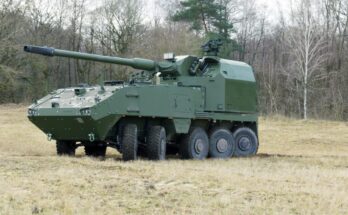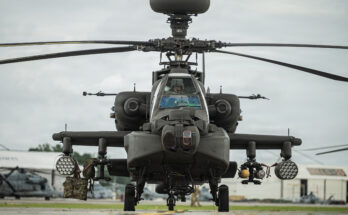
For those watching the U.S. military’s evolving vision for future aircraft programs, DARPA’s ongoing X-plane competition is a must-watch. As the Pentagon shapes its needs for the next generation of military aircraft, the Speed and Runway Independent Technologies (SPRINT) project offers insights into the potential design trends of future airframes.
SPRINT, a co-led Defense Advanced Research Projects Agency and U.S. Special Operations Command (SOCOM) effort, has contracted Aurora Flight Sciences and Bell Textron to design aircraft capable of 400 to 450-knot cruise speeds and unprepared and runway-free terrain landing.
To meet these goals, the aircraft must combine jet propulsion with vertical take-off and landing elements reminiscent of aircraft like the late McDonnell Douglas AV-8B Harrier and modern Lockheed Martin F-35B. Though both fighters can exceed speeds of 450 knots, the SPRINT program also requires a payload capability to support broader missions like troop and supply transport.
Logistics missions better suit tiltrotor aircraft like the Bell/Boeing V-22 Osprey or Bell V-280 Valor selected as the U.S. Army’s Future Long Range Assault Aircraft (FLRAA). Yet the new V-280 still falls some 100 knots short of the DARPA requirement with a max cruise speed of 305 knots. This indicates the SPRINT program demands a design blend of jet-powered fighter-like speed with tiltrotor load capacity–an aircraft type not yet in production.
The requirements underline an urgent need for U.S. decision makers eyeing future aircraft built for the vast range and distance challenges posed by operations in the contested Pacific region. With the U.S. Army FLRAA fielding set near the decade’s end, all four U.S. service branches will soon operate tiltrotor aircraft. Considering the diverse land and sea environments of the Pacific, the Pentagon has signaled its intent to invest in multi-purpose high-speed hovering aircraft.
Divergent Visions
In view of the long-term future of DOD aircraft acquisitions and likely every military branch as a customer on the line, the stakes to deliver an effective design are high. Aurora Flight Sciences, a Boeing subsidiary, and Bell were down-selected in May 2024 and awarded contracts as part of Phase 1B. By April 2025, both companies will finalize their plans for preliminary design review. Recent renderings and program updates reveal that each airframer is taking a distinct approach, setting the stage for differing visions of high-speed, runway-independent aircraft.

In October, Aurora published an update unveiling concepts for a blended wing design incorporating fan-in-wing (FIW) technology. Aurora notes its plans will afford unprecedented stealth for “airborne logistics and personnel recovery missions” in contested areas. FIX will embed lift fans into the airframe for vertical takeoff and landing. Aurora’s uncrewed X-plane demonstrator will use available turbofan and turboshaft engines fitted on a 45-foot aircraft with a 1,000-pound payload capacity.
A prominent feature of the future technology is the ability to scale it. Aurora states it could support a family of systems model to apply to large manned medium and heavy-lift aircraft. Renderings reveal an approach not unlike Northrop Grumman’s all-wing B-21 bomber, favoring a fixed-wing low-observability option for stealth performance.
In a December press release, Bell announced that it completed wind tunnel testing on its revolutionary Stop/Fold rotor system. Bell’s X-plane renderings show a rotary-wing model scalable for crewed and uncrewed aircraft. The Fort-Worth-based builder’s focus on foldable rotors is part of its High-Speed Vertical Takeoff and Landing (HSVTOL) technology to support the transition to fast cruise flight likely supplemented by jet propulsion.
Bell released a video in February demonstrating the HSVTOL capability. The video shows a rotor and engine fitted on a test sled. While in motion, the proprotor blades transition from rotating to feathering to folding and stowing, a remarkable feat to the casual observer. So far, Bell has been less forthcoming about its X-plane prototype details. However, given the company’s decades-long focus on tiltrotor technology and anticipated success with the V-280, the proprotor-based HSVTOL system will underpin their SPRINT aircraft offering.
Analysis
Based on the two early concepts, differing philosophies on the future of high-speed utility flight are taking shape. Aurora’s design sides more strongly with the fixed-wing camp in a likely effort to prioritize high-performance speed and stealth. This vision could lead to greater range across scalable aircraft compared to an aircraft fitted with rotors. In contrast, Bell’s proprotor model would almost certainly have a larger radar cross signature. Yet, the Bell HSVTOL design draws on established tiltrotor models in the V-22 and V-280, aircraft DOD operators have heralded for their capabilities.

Bell’s SPRINT airframe design closely resembles its uncrewed V-247 Vigilant tiltrotor prototype. As U.S. Navy MH-60R and MH-60S helicopters near the end of their service life during the next decade, Bell hopes a marinized variant of the V-280 tiltrotor leveraged alongside the V-247 drone will succeed those helicopters for the Navy’s Future Vertical Lift (Maritime Strike) (FVL (MS)) program. According to Bell, the V-247 will achieve 300+ knots with a 1,000-pound internal payload capability.
With a form of the V-280 slated for fielding by the U.S. Army and SOCOM, along with plans for a future Manned-Unmanned teaming (MUM-T) model for the U.S. Navy, Bell has staked out a strong position for the tiltrotor as a staple of future DOD aircraft programs. If the company can translate its tiltrotor capabilities into a high-speed option for SPRINT, it will emerge as a frontrunner for next-generation aircraft design.
Ultimately, any selection is sure to hinge on deliverability, particularly on range. Proof of concept remains paramount for military leaders facing a rapidly shrinking window to establish aviation warfare solutions sorely needed for any looming confrontation in the Indo-Pacific and elsewhere.
A former naval officer and helicopter pilot, Jon covers a range of Forecast International reports and products, drawing on his 10-year background in military aviation, operations, and education. His previous military assignments include multiple overseas deployments supporting operations in the Arabian Gulf, NATO exercises, and humanitarian missions. Jon’s work is also influenced by his time as a former Presidential Management Fellow and international trade specialist at the Department of Commerce.
Before joining Forecast International, Jon also served as an NROTC instructor and Adjunct Assistant Professor at the University of Texas, where he taught undergraduate courses on naval history, navigation, defense organization, and naval operations and warfare. A lifelong reader and learner, his academic and professional interests include aviation, political and military history, national defense and security, and foreign area studies.




